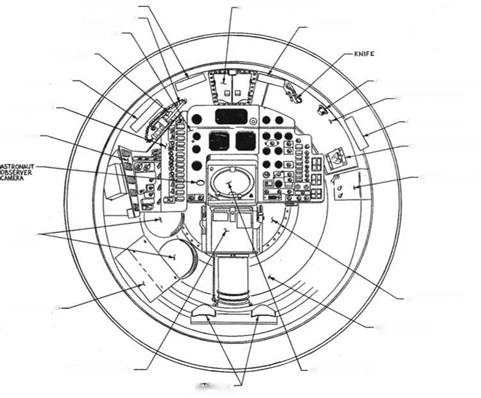END OF WEIGHTLESSNESS
At 230,000 feet, as Freedom 7 began to penetrate the fringes of the atmosphere, a relay was actuated in response to the onset of 0.05 g. As Shepard later explained, this indicated that the reentry phase had truly begun:
I had planned to be on manual control when this happened and run off a few more tests with my hand controls before we penetrated too deeply into the atmosphere. But the g-forces had built up before I was ready for them, and I was a

few seconds behind. I was fairly busy for a moment running around the cockpit with my hands, changing from the autopilot to manual controls, and I managed to get in only a few more corrections in attitude. Then the pressure of the air we were coming into began to overcome the force of the control jets and it was no longer possible to make the capsule respond. Fortunately, we were in good shape, and I had nothing to worry about so far as the capsule’s attitude was concerned. I knew, however, that the ride down was not one most people would want to try in an amusement park [19].
It was never widely reported, but there was a little high-drama occurring at that time away from Freedom 7. As revealed by Shepard in an interview with American Heritage Magazine in 1994, it began when Slayton cautiously asked Shepard if he could see the Redstone rocket. Some engineers had expressed concern that when he fired the retrorockets and slowed the spacecraft, the tumbling booster might actually catch up. He responded in the negative, but reasoned that the booster ought, by then, to be well below his altitude. And this was indeed the case. As the booster penetrated into the atmosphere it began to disintegrate. However, as Shepard related, there was an unexpected near-miss. As the charred remains hurtled towards the ocean, sending violent shock waves through the air, this caused mounting terror for the crew of a freighter who saw a long object falling towards them. As they watched, the Redstone passed high over the ship and smashed heavily into the Atlantic just a few miles east of their position. The ship’s radio operator sent out an urgent distress call, the crew suspecting they might have witnessed the death plunge of an airplane. Fortunately, a radio engineer from NBC was on Grand Bahama Island that day, heard their call, and reassured the freighter’s crew that instead of a tragedy, they had witnessed the final moments of the rocket which carried America’s first astronaut into space [20].
Aboard Freedom 7, the build-up of gravity came swiftly as the spacecraft plunged through the atmosphere. Pressed ever harder into his contour couch, Shepard noted three, then six, then nine times the force of gravity. The load peaked at 11 g’s, which meant in Earth terms that he weighed close to a ton. “But I’d pulled eleven-g loads in the centrifuge, and I knew I could keep on working now.” [21]
Shepard never reached the point – as he often had during grueling hours spent on the Johnsville centrifuge – of having to exert the maximum effort simply to speak or even to breathe:
All the way down, as the altimeter spun through mile after mile of descent, I kept grunting out ‘O. K., O. K., O. K.,’ just to show them back in the Control Center how I was doing. The periscope had come back in automatically before the reentry started. And there was nothing for me to do now but just wait for the final act to begin.
All through this period of falling, the capsule rolled around very slowly in a counterclockwise direction, spinning at a rate of about 10 degrees per second around its long axis. This was programmed to even out the heat and it did not bother me. Neither did the sudden rise in temperature as the friction of the air began to build up outside the capsule. The temperature climbed to 1,230 degrees Fahrenheit on the outer walls. But it never went above 100 degrees in the cabin or above 82 degrees in my suit [22].
Then, as the g-forces began to diminish at around 80,000 feet, Shepard switched from fly-by-wire mode back to autopilot. The altimeter was rapidly winding down, and showing 31,000 feet when Slayton’s voice assured Shepard that his impact site would be right on the money.
“Great news,” Shepard would later recall. “Flight computations were as close to perfect as could be, and so were the performances of the Redstone and the spacecraft…. The Cape lay 300 miles to the northwest and with the diminishing altitude would soon be out of radio contact. I signed off with Deke, telling him I was going to the new frequency.
“‘Roger, Seven, read you switching to GBI [Grand Bahama Island].’
“He was eager to get the hell out of Mercury Control Center as fast as he could. I knew Gus would be right there with him, and the two of them would clamber into a NASA jet and burn sky to GBI so they could be on the ground waiting when I was delivered by helicopter from the recovery vessel.” [23]











